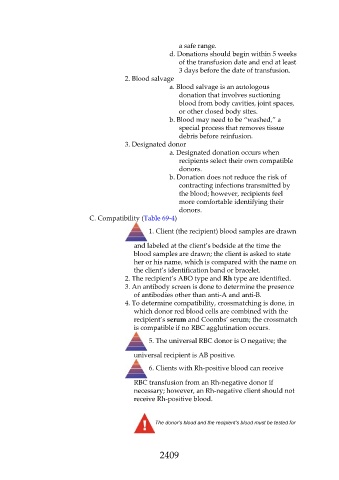Page 2409 - Saunders Comprehensive Review For NCLEX-RN
P. 2409
a safe range.
d. Donations should begin within 5 weeks
of the transfusion date and end at least
3 days before the date of transfusion.
2. Blood salvage
a. Blood salvage is an autologous
donation that involves suctioning
blood from body cavities, joint spaces,
or other closed body sites.
b. Blood may need to be “washed,” a
special process that removes tissue
debris before reinfusion.
3. Designated donor
a. Designated donation occurs when
recipients select their own compatible
donors.
b. Donation does not reduce the risk of
contracting infections transmitted by
the blood; however, recipients feel
more comfortable identifying their
donors.
C. Compatibility (Table 69-4)
1. Client (the recipient) blood samples are drawn
and labeled at the client’s bedside at the time the
blood samples are drawn; the client is asked to state
her or his name, which is compared with the name on
the client’s identification band or bracelet.
2. The recipient’s ABO type and Rh type are identified.
3. An antibody screen is done to determine the presence
of antibodies other than anti-A and anti-B.
4. To determine compatibility, crossmatching is done, in
which donor red blood cells are combined with the
recipient’s serum and Coombs’ serum; the crossmatch
is compatible if no RBC agglutination occurs.
5. The universal RBC donor is O negative; the
universal recipient is AB positive.
6. Clients with Rh-positive blood can receive
RBC transfusion from an Rh-negative donor if
necessary; however, an Rh-negative client should not
receive Rh-positive blood.
The donor’s blood and the recipient’s blood must be tested for
2409

